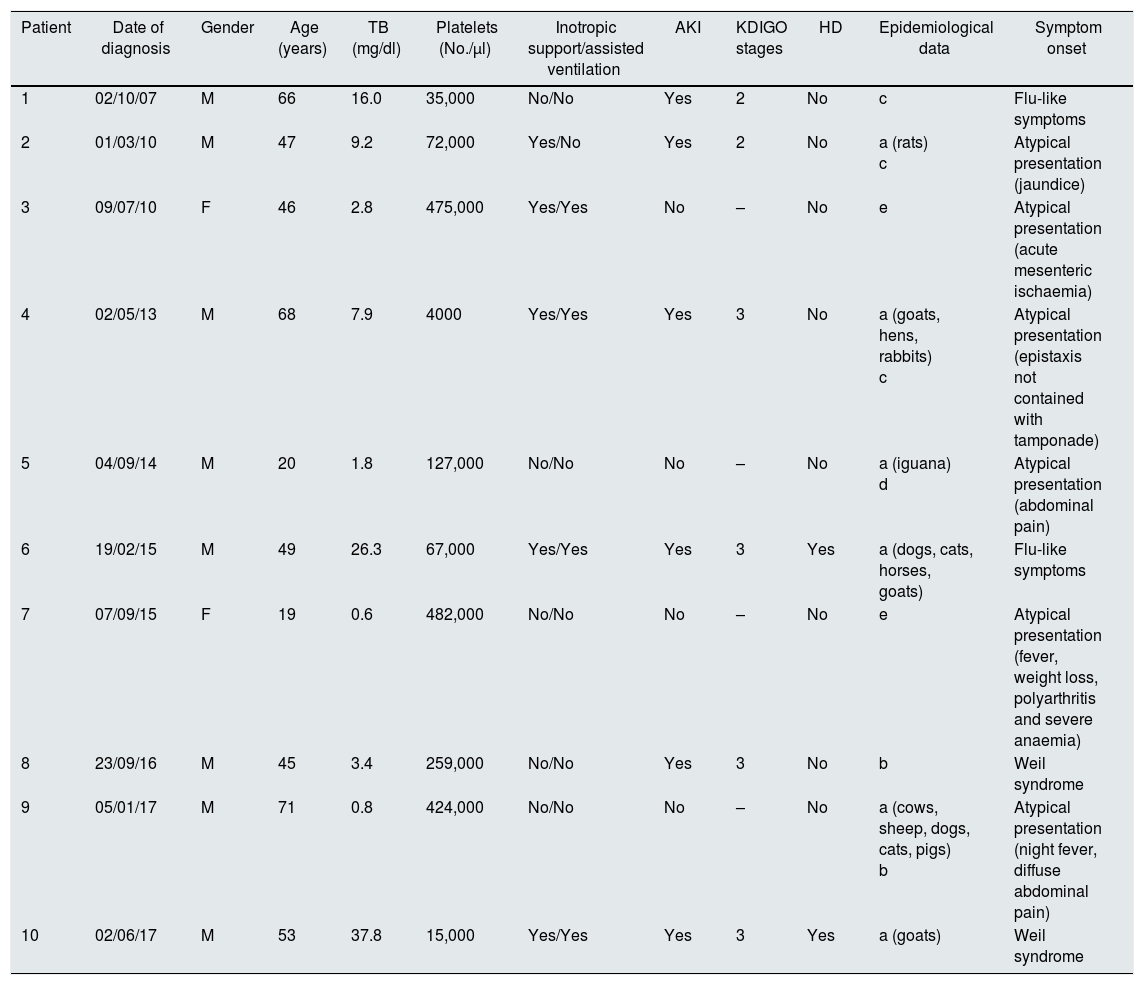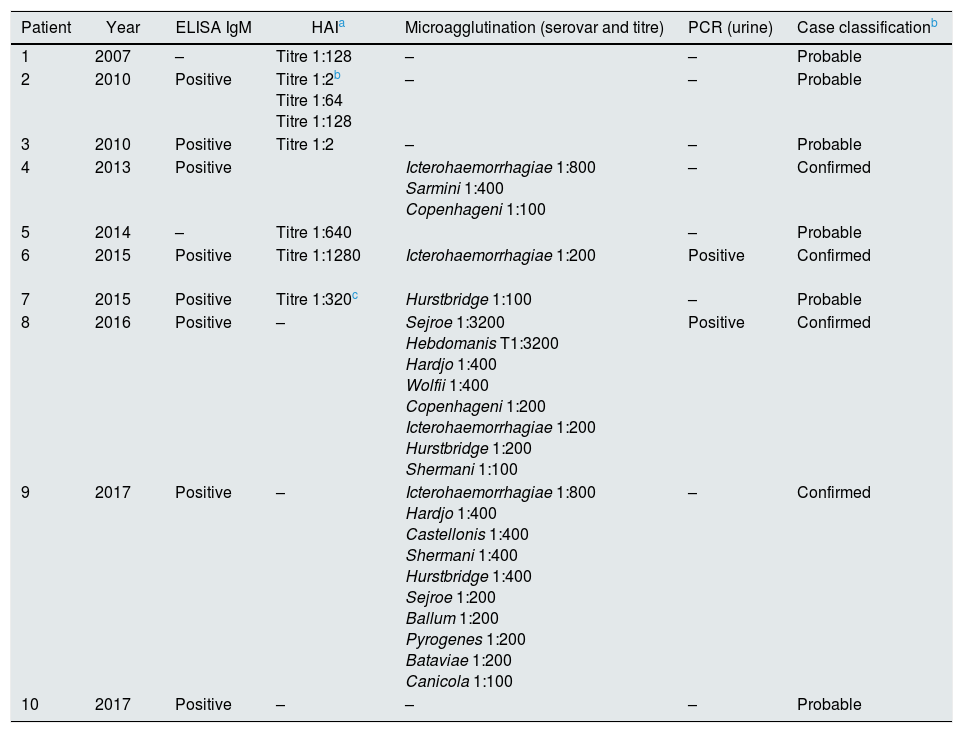Leptospirosis is a zoonotic disease, which occurs all over the world and is related to direct or indirect contact of humans with the urine of infected animals.1 The clinical manifestations are highly variable, from flu-like symptoms to very serious forms (Weil's disease with liver, kidney and meningeal involvement and alterations in haemostasis).1–3 Leptospirosis causes acute interstitial nephritis which often presents either as asymptomatic urinary abnormalities (mild proteinuria, microhaematuria); acute kidney injury (AKI), which is typically non-oliguric and hypokalaemic, like a haemolytic uraemic syndrome (HUS); or chronic kidney disease (CKD) of unknown aetiology.4 Although the diagnosis of leptospirosis is not common, severe cases with AKI are the main reason for requiring nephrology treatment. For that reason, we carried out a retrospective descriptive study of all the cases of leptospirosis diagnosed in our hospital in the period 2007–2017. Our study had the approval of the Continuing Education, Teaching and Research Commission. The immunodiagnostic techniques used for the screening were serum detection of total antibodies by indirect haemagglutination and/or IgM antibodies by ELISA, with positive cases confirmed by microscopic agglutination test (MAT) in serum and/or detection of Leptospira sp. DNA in urine by real-time PCR. We used the diagnostic criteria of the Centers for Disease Control and Prevention (CDC), classifying the cases as confirmed or probable. In total, 10 cases of leptospirosis were diagnosed (8 men and 2 women). Table 1 shows the clinical-analytical data of the patients studied, the possible sources of infection and the form of presentation. Six of the eight males had AKI. Of these, only two required haemodialysis; both were transferred to intensive care for inotropic support and assisted ventilation, these two being the cases with the highest levels of serum bilirubin. All patients survived. Eight patients had suggestive epidemiological factors (some more than one factor) and in two cases they were not known. In terms of clinical presentation, two presented with flu-like symptoms, two with Weil's disease and six with atypical manifestations. Table 2 shows the microbiological diagnostic techniques used and the titres of the different varieties. Of the 10 patients studied, four met diagnostic criteria, with an antibody titre by MAT >1:800 and/or detection of Leptospira DNA in urine by real-time PCR. The remaining six patients had positive screening for indirect haemagglutination and/or IgM ELISA without diagnostic confirmation criteria. MAT is the “gold standard” in the immunodiagnosis of leptospirosis due to its specificity (serovariety/serogroup). As MAT requires isolation of the microorganism by culture and experience in the isolation, it is performed in reference laboratories and is therefore not always available. The serovarieties was icterohaemorrhagiae (rats) in three of the cases determined by MAT. Leptospirosis-associated AKI occurs in 44–66% of affected patients,5 and our series was 60% which is n the same line with that range with developing AKI. According to the KDIGO (Kidney Disease: Improving Global Outcomes) guidelines for AKI,6 four had stage 3 and two, stage 2. As in this series, most cases of AKI are associated with jaundice.4 Although the most common is non-oliguric AKI, in cases associated with jaundice and/or hypotension, oliguric or anuric AKI can occur and if necessary, both haemodialysis and peritoneal dialysis can be given. Most patients recover renal function, but in some patients a degree of renal failure may persist and progress to CKD. In a recent article in which renal biopsy was performed after recovery of the patient with antibiotics, inflammatory infiltration was demonstrated in both the tubules and in the interstitium, where most of the cells were monocytes or CD68-positive macrophages predominantly of the M1 phenotype.7 After treatment with oral corticosteroids, the patient recovered renal function, which is why the authors suggest that corticosteroids may be a therapeutic option for some patients with sustained tubulointerstitial nephritis after surviving severe leptospirosis.7
Clinical, analytical and epidemiological data and clinical presentation for the patients infected with leptospirosis.
| Patient | Date of diagnosis | Gender | Age (years) | TB (mg/dl) | Platelets (No./μl) | Inotropic support/assisted ventilation | AKI | KDIGO stages | HD | Epidemiological data | Symptom onset |
|---|---|---|---|---|---|---|---|---|---|---|---|
| 1 | 02/10/07 | M | 66 | 16.0 | 35,000 | No/No | Yes | 2 | No | c | Flu-like symptoms |
| 2 | 01/03/10 | M | 47 | 9.2 | 72,000 | Yes/No | Yes | 2 | No | a (rats) c | Atypical presentation (jaundice) |
| 3 | 09/07/10 | F | 46 | 2.8 | 475,000 | Yes/Yes | No | – | No | e | Atypical presentation (acute mesenteric ischaemia) |
| 4 | 02/05/13 | M | 68 | 7.9 | 4000 | Yes/Yes | Yes | 3 | No | a (goats, hens, rabbits) c | Atypical presentation (epistaxis not contained with tamponade) |
| 5 | 04/09/14 | M | 20 | 1.8 | 127,000 | No/No | No | – | No | a (iguana) d | Atypical presentation (abdominal pain) |
| 6 | 19/02/15 | M | 49 | 26.3 | 67,000 | Yes/Yes | Yes | 3 | Yes | a (dogs, cats, horses, goats) | Flu-like symptoms |
| 7 | 07/09/15 | F | 19 | 0.6 | 482,000 | No/No | No | – | No | e | Atypical presentation (fever, weight loss, polyarthritis and severe anaemia) |
| 8 | 23/09/16 | M | 45 | 3.4 | 259,000 | No/No | Yes | 3 | No | b | Weil syndrome |
| 9 | 05/01/17 | M | 71 | 0.8 | 424,000 | No/No | No | – | No | a (cows, sheep, dogs, cats, pigs) b | Atypical presentation (night fever, diffuse abdominal pain) |
| 10 | 02/06/17 | M | 53 | 37.8 | 15,000 | Yes/Yes | Yes | 3 | Yes | a (goats) | Weil syndrome |
AKI: acute kidney injury; Creat (s): serum creatinine; F: female; HD: haemodialysis; M: male; TB: total bilirubin.
Epidemiological data: a: contact with mammals; b: fresh water bathing; c: unpasteurised food intake; d: trips abroad; e: unknown.
Microbiological results of patients diagnosed with leptospirosis.
| Patient | Year | ELISA IgM | HAIa | Microagglutination (serovar and titre) | PCR (urine) | Case classificationb |
|---|---|---|---|---|---|---|
| 1 | 2007 | – | Titre 1:128 | – | – | Probable |
| 2 | 2010 | Positive | Titre 1:2b Titre 1:64 Titre 1:128 | – | – | Probable |
| 3 | 2010 | Positive | Titre 1:2 | – | – | Probable |
| 4 | 2013 | Positive | Icterohaemorrhagiae 1:800 Sarmini 1:400 Copenhageni 1:100 | – | Confirmed | |
| 5 | 2014 | – | Titre 1:640 | – | Probable | |
| 6 | 2015 | Positive | Titre 1:1280 | Icterohaemorrhagiae 1:200 | Positive | Confirmed |
| 7 | 2015 | Positive | Titre 1:320c | Hurstbridge 1:100 | – | Probable |
| 8 | 2016 | Positive | – | Sejroe 1:3200 Hebdomanis T1:3200 Hardjo 1:400 Wolfii 1:400 Copenhageni 1:200 Icterohaemorrhagiae 1:200 Hurstbridge 1:200 Shermani 1:100 | Positive | Confirmed |
| 9 | 2017 | Positive | – | Icterohaemorrhagiae 1:800 Hardjo 1:400 Castellonis 1:400 Shermani 1:400 Hurstbridge 1:400 Sejroe 1:200 Ballum 1:200 Pyrogenes 1:200 Bataviae 1:200 Canicola 1:100 | – | Confirmed |
| 10 | 2017 | Positive | – | – | – | Probable |
In summary, leptospirosis causes acute interstitial nephritis which can simply result in asymptomatic urinary alterations, but may also lead to typically non-oliguric AKI. In cases associated with jaundice and hypotension (hypovolaemic or associated with myocarditis), the patient could develop oliguric or anuric AKI, which may require dialysis. Although these patients generally recover renal function, some may go on to develop CKD. In certain cases, if a patient presents with CKD of unknown or unidentified aetiology, depending on their medical history, it could be useful to test for anti-Leptospira antibodies or Leptospira in urine by PCR.8–10 In view of the fact that 60% of our patients had atypical presentation of a disease which is uncommon in our environment (10 cases in 10 years), we felt it necessary to highlight the importance of diagnosing and treating this condition in patients who have had contact with untreated waters.
To Mr Manuel Plazuelo of Reference Laboratory for performing the haemagglutination technique, and to Mr Horacio Gil and Ms Isabel Jado of the Centro Nacional de Microbiología, Instituto de Salud Carlos III [Spanish National Microbiology Centre, Carlos III Health Institute], for confirming the cases by ELISA IgM, MAT and PCR.
Please cite this article as: Esparza Martín N, Hernández Betancor A, Rivero Viera Y, Fernández Granados S, Suria González S, Guerra Rodríguez R, et al. Fracaso renal agudo asociado a leptospirosis. Nefrologia. 2019;39:213–216.







